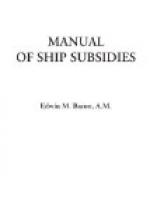No further move for fostering the American merchant marine with State aid directly or indirectly, was made till 1864. Then the steamship-subsidizing policy was revived, first with a proposition for the establishment of an American mail-line to Brazil. A subsidy of two hundred and fifty thousand dollars per year was proposed, one hundred and fifty thousand to be paid by the United States and one hundred thousand by the Brazilian Government. Congress endorsed the scheme. The act embodying it (May 28)[HB] authorized the postmaster-general to contract for a monthly service between the two countries, touching at St. Thomas, W.I., by first-class American sea-going steamships of not less than 2000 tons. The steamers were to be built under naval inspection, and to be subject to taking for war service. Bids were to be openly advertised for. The contract was to run for ten years. Thus was established the pioneer American line between Philadelphia and Rio de Janeiro, which continued from 1865 to 1876, and was then abandoned.
In the same session of Congress a bill was introduced, authorizing an annual subsidy of five hundred thousand dollars for an ocean mail-steamship service to Japan and China via Hawaii. This also received favorable consideration, and was passed February 17, 1865. The service was to be monthly, performed by American-built ships of not less than 3000 tons, also constructed under naval inspection. Tenders for the contract were to be advertised for, but bids only from United States citizens were to be entertained. The contract was to run for ten years. Only one bidder appeared (as was evidently expected)—the Pacific Mail Steamship Company. The contract went to that company, and under it, in 1867, their prosperous Asiatic service began. At the outset they were released from the obligation of stopping at Hawaii, and Congress voted another subsidy—seventy five thousand dollars per annum—for a distinct Hawaiian service.[HC] The contract for this service, also advertised for, went to the California, Oregon, and Mexican Line.
* * * * *
Thus far the granting of postal subsidies for the establishment of steamship lines alone had engaged the advocates of State aid to American shipping. Now was agitated the institution of a general subsidy system as a means of fostering the rehabilitation of the merchant marine of all classes in ocean service, sailing-ships as well as steamers. The situation had become acute. Through the great loss of tonnage in the Civil War, and through the steadily advancing change from wood to iron in ship construction and from sail to steam propulsion, the American merchant marine had been brought distressingly low. From 1861, when the United States was standing second in rank among the nations in the extent of her ocean tonnage, to 1866, this tonnage had declined from 2,642,648 to 1,492,926 tons: a loss of more than forty-three per cent; while England, the first in rank and chief




